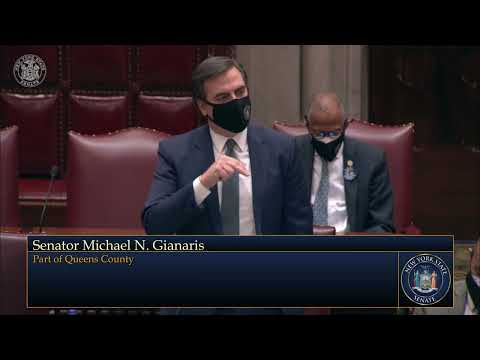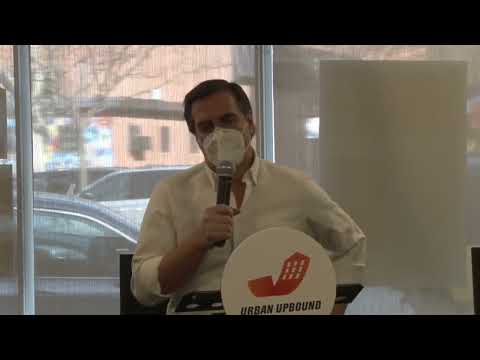
Department of Environmental Protection Joins Environmental Advocates and Community Leaders to Celebrate Installation of New Tidal Wetlands in Newtown Creek at Dutch Kills
July 12, 2018

New York City Department of Environmental Protection (DEP) Commissioner Vincent Sapienza today joined Council Member James Van Bramer, leading New York City environmental groups including the Newtown Creek Alliance, Riverkeeper and Stormwater Infrastructure Matters (SWIM), and educators and students from LaGuardia Community College to celebrate the installation of tidal wetlands in Newtown Creek at Dutch Kills. The wetlands will help to improve water quality, provide habitat for wildlife and a more natural aesthetic area for the community. This is the first time Newtown Creek has had substantial wetlands in more than 100 years.
“After completing a pilot wetland project at Dutch Kills in 2015, we have discovered that wetlands can not only survive in Newtown Creek, but they can potentially thrive,” said DEP Commissioner Vincent Sapienza. “Wetlands play a critical role in our ecosystem and they help to improve the health of waterbodies, which is why we are building them wherever we can in the five boroughs.”
"This is a victory for the environment and will help preserve the ecosystem of western Queens," said Senator Michael Gianaris. "I thank DEP for its work and everyone who made this possible."
"Restoring our natural environment is a key goal for our community,” said Assembly Member Catherine Nolan. “My gratitude to the community advocates including Mitch Waxman, Newtown Creek expert, Dorothy Morehead, Queens CB 2, Dr. Gail Mellow for her support from LaGuardia Community College, the Newtown Creek Alliance and so many others who are creating something so important and healthful.”
“Our wetlands and waterways are essential to the landscape and urban environment of our City,” said New York City Council Member Jimmy Van Bramer. “The planting of this 10,000 square feet of new wetlands in Dutch Kills shows the resilience of our waterways and how with the work of a few creative people, we can bring about real and lasting change in our community. We must work to clean this waterway as quickly as we can.”
“Restoring a salt marsh within Dutch Kills will provide great ecological benefits to returning wildlife and complement recent reductions in sewage overflow. It is a small but important step to rectify the centuries of pollution and neglect Newtown Creek and its tributaries have suffered,” said Willis Elkins, Program Manager for Newtown Creek Alliance. “We welcome this project and encourage the City to move forward expeditiously on additional investments in green infrastructure and sewer upgrades that will continue to improve water quality within the Creek.”
“We are thrilled to see these wetland installations in Dutch Kills,” said Julie Welch, Program Manager for the SWIM Coalition. “The wetlands will make the shoreline more resilient, improve water quality, create habitats for wildlife, and provide a more calming waterfront for people. These wetlands are also identified as opportunities for Dutch Kills in the Newtown Creek Vision Plan and we believe these wetland installations are a great start to implementing the plan. We hope to see more wetland installations in Newtown Creek.”
“We are happy to see that DEP is investing in projects that are not only good for the environment, but also enhance the waterway for the people who work and study in the area surrounding Dutch Kills.” said Liz Lusskin, President of the Long Island City Partnership. “We look forward to working with DEP to roll out more projects like this one that contribute to the innovative ethos of the area.”
Through this project, the Dutch Kills western terminus site has received placement of 1,400 cubic yards of sand to establish proper elevations to support the growth of 1,455 square feet of Spartina alterniflora plugs. The scope of work for a 2015 pilot study in Dutch Kills previously consisted of the placement of 500 cubic yards of sand in a 0.09 acre area along the bulkhead.
At the Hunters Point Avenue Bridge, 3,300 cubic yards of sand have been added on the bridge’s western and eastern sides to establish the proper elevations to support the growth of 6,900 square feet of Spartina alterniflora plugs.
Wetlands, which are transitional lands between aquatic and terrestrial ecosystems, provide a wide variety of beneficial functions. They attenuate flooding, help maintain stream flow, improve water quality, absorb nutrients and carbon, and provide plant and wildlife habitat. Nearly half the nation’s threatened and endangered species rely on wetlands to survive.
Attention has recently been focused on the ability of wetlands to sequester pathogens, improve water quality, and reduce nutrient levels. With this ability, natural and constructed wetlands have been widely utilized for water quality enhancement. The flooding and ebbing of tidal waters through a wetland can increase the mortality, and subsequently decrease pathogens by sequestering them within the marsh sediments and increasing their exposure to harmful Ultraviolet light. The presence of vegetation within wetlands provides a source of oxygen into surface waters to help improve water quality within coastal ecosystems. Dissolved Oxygen improvements can be attributed to both the roots and the stems of wetland plants.
The Newtown Creek waterbody and watershed includes Newtown Creek, Dutch Kills, Maspeth Creek, East Branch and English Kills waterbodies and defines the border between Brooklyn and Queens. Newtown Creek is a tributary to the East River, and was originally a stream draining the uplands of western Long Island. Urbanization and heavy shipping traffic significantly modified the course and channel of Newtown Creek over the years, most notably filling the inland streams, and widening and deepening the downstream end. By the mid-1800s, the creek was one of the busiest industrial areas in the world, crowded with ships importing raw materials and fuel and exporting oil, chemicals and metals. More than 50 industrial businesses lined its banks including oil refineries, petrochemical plants, fertilizer and glue factories, sawmills, and lumber and coal yards.
In 1967 New York City constructed the Newtown Creek Wastewater Treatment Plant to treat sanitary sewage during dry weather and to capture a portion of the combined sewage and storm flow generated during wet weather. Over the last several years, the City has invested nearly $260 million in capital projects to improve water quality in Newtown Creek. In addition, the NYS Department of Environmental Conservation recently approved the City’s Long Term Control Plan for Newtown Creek that provides for an additional $1.4 billion investment to reduce the volume of combined sewer overflows to Newtown Creek during wet weather. Thanks to these projects and the efforts of many advocacy groups including the Newtown Creek Alliance, Riverkeeper, and the SWIM Coalition, life has slowly started to return to the Creek, as evident by the current prevalence of blue crab, fish, and waterfowl.
DEP manages New York City’s water supply, providing more than 1 billion gallons of water each day to more than 9.6 million residents, including 8.6 million in New York City. The water is delivered from a watershed that extends more than 125 miles from the city, comprising 19 reservoirs and three controlled lakes. Approximately 7,000 miles of water mains, tunnels and aqueducts bring water to homes and businesses throughout the five boroughs, and 7,500 miles of sewer lines and 96 pump stations take wastewater to 14 in-city treatment plants. DEP has nearly 6,000 employees, including almost 1,000 in the upstate watershed. In addition, DEP has a robust capital program, with a planned $19.4 billion in investments over the next 10 years that will create up to 3,000 construction-related jobs per year. For more information, visit nyc.gov/dep, like us on Facebook, or follow us on Twitter.
Share this Article or Press Release
Newsroom
Go to NewsroomSenator Gianaris' Floor Speech on Redistricting
February 3, 2022

Senator Gianaris Joins Urban Upbound JobsPlus Announcement
January 25, 2022

New York's Emergency Rental Assistance Program
January 24, 2022

